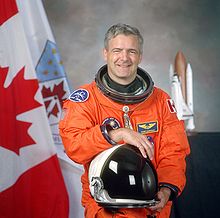Marc Garneau
Canadian - (CSA)
Deceased
Date of Birth: Feb. 23, 1949
Date of Death: June 4, 2025
Garneau was one of the first Canadian Astronauts and he became the first Canadian in outer space in October 1984. In 1984, he was seconded to the new Canadian Astronaut Program (CAP), one of six chosen from over 4,000 applicants. He flew on the shuttle Challenger, STS-41-G from October 5 to 13, 1984, as payload specialist. He was promoted to Captain in 1986, and left the Navy in 1989, to become deputy director of the CAP. In 1992–93, he underwent further training to become a mission specialist. He worked as CAPCOM for a number of shuttle flights and was on two further flights himself: STS-77 (May 19 to 29, 1996) and STS-97 (to the ISS, November 30 to December 11, 2000). He has logged over 677 hours in space. In February 2001, he was appointed executive vice-president of the Canadian Space Agency, and became its president on November 22, 2001.
Space Shuttle Challenger / OV-099 | STS-41-G
National Aeronautics and Space Administration | United States of AmericaKennedy Space Center, FL, USA
Oct. 5, 1984, 11:03 a.m.
Status: Success
Mission:
STS-41-G was the thirteenth flight of the shuttle program and sixth of the Space Shuttle Challenger. It was the second landing made at the Kenendy Space Center. It was the first crew to carry two women, the first American EVA involving a woman, the first Australian Astronaut and first Canadian Astronaut.
Low Earth OrbitSpace Shuttle Endeavour / OV-105 | STS-77
National Aeronautics and Space Administration | United States of AmericaKennedy Space Center, FL, USA
May 19, 1996, 10:30 a.m.
Status: Success
Mission:
STS-77 was the 77th Space Shuttle mission and the 11th mission of the Space Shuttle Endeavour. The mission began from launch pad 39B from Kennedy Space Center, Florida on 19 May 1996 lasting 10 days and 40 minutes and completing 161 revolutions before landing on runway 33.
Low Earth OrbitSpace Shuttle Endeavour / OV-105 | STS-97
National Aeronautics and Space Administration | United States of AmericaKennedy Space Center, FL, USA
Dec. 1, 2000, 3:06 a.m.
Status: Success
Mission:
STS-97 was a Space Shuttle mission to the International Space Station (ISS) flown by Space Shuttle Endeavour. The crew installed the first set of solar arrays to the ISS, prepared a docking port for arrival of the Destiny Laboratory Module, and delivered supplies for the station's crew.
Low Earth OrbitThe Canadian Space Agency was established by the Canadian Space Agency Act which received Royal Assent on May 10, 1990. The Canadian space program is administered by the Canadian Space Agency. Canada has contributed technology, expertise and personnel to the world space effort, especially in collaboration with ESA and NASA. In addition to its astronauts and satellites, some of the most notable Canadian technological contributions to space exploration include the Canadarm on the Space Shuttle and Canadarm2 on the International Space Station.
Long March 12A
Demo Flight
Long March 12A Pad - Jiuquan Satellite Launch Center, People's Republic of ChinaFirst test launch of CASC/SAST’s Long March 12A rocket, with a dummy payload. The rocket’s 1st stage attempted to land on a landing pad about 300 km …
HANBIT-Nano
Spaceward
HANBIT Pad - Alcântara Space Center, Federative Republic of BrazilMaiden orbital launch attempt for the South Korean stratup Innospace and its HANBIT-Nano small launch vehicle. Onboard this flight are five small sat…
H3-22
Michibiki 5 (QZS-5)
Yoshinobu Launch Complex LP-2 - Tanegashima Space Center, JapanQZSS (Quasi Zenith Satellite System) is a Japanese satellite navigation system operating from inclined, elliptical geosynchronous orbits to achieve o…
Electron
The Wisdom God Guides (iQPS Launch 6)
Rocket Lab Launch Complex 1B - Rocket Lab Launch Complex 1, Mahia Peninsula, New ZealandSynthetic aperture radar Earth observation satellite for Japanese Earth imaging company iQPS.
New Shepard
NS-37
West Texas Suborbital Launch Site/ Corn Ranch - Corn Ranch, Van Horn, TX, USANS-37 is the 16th crewed flight for the New Shepard program and the 37th in the New Shepard program's history.



